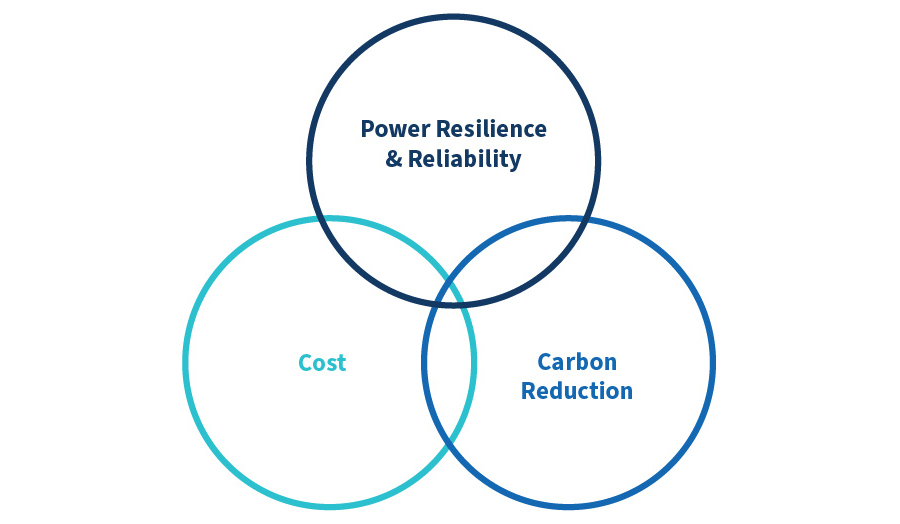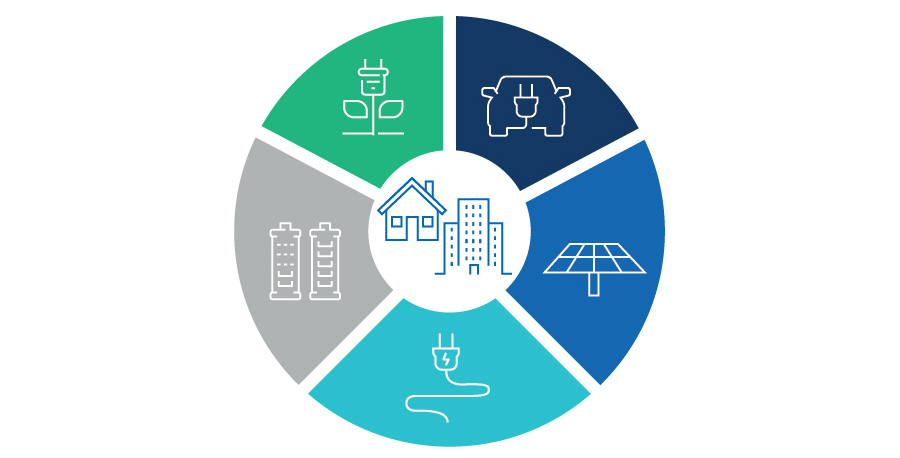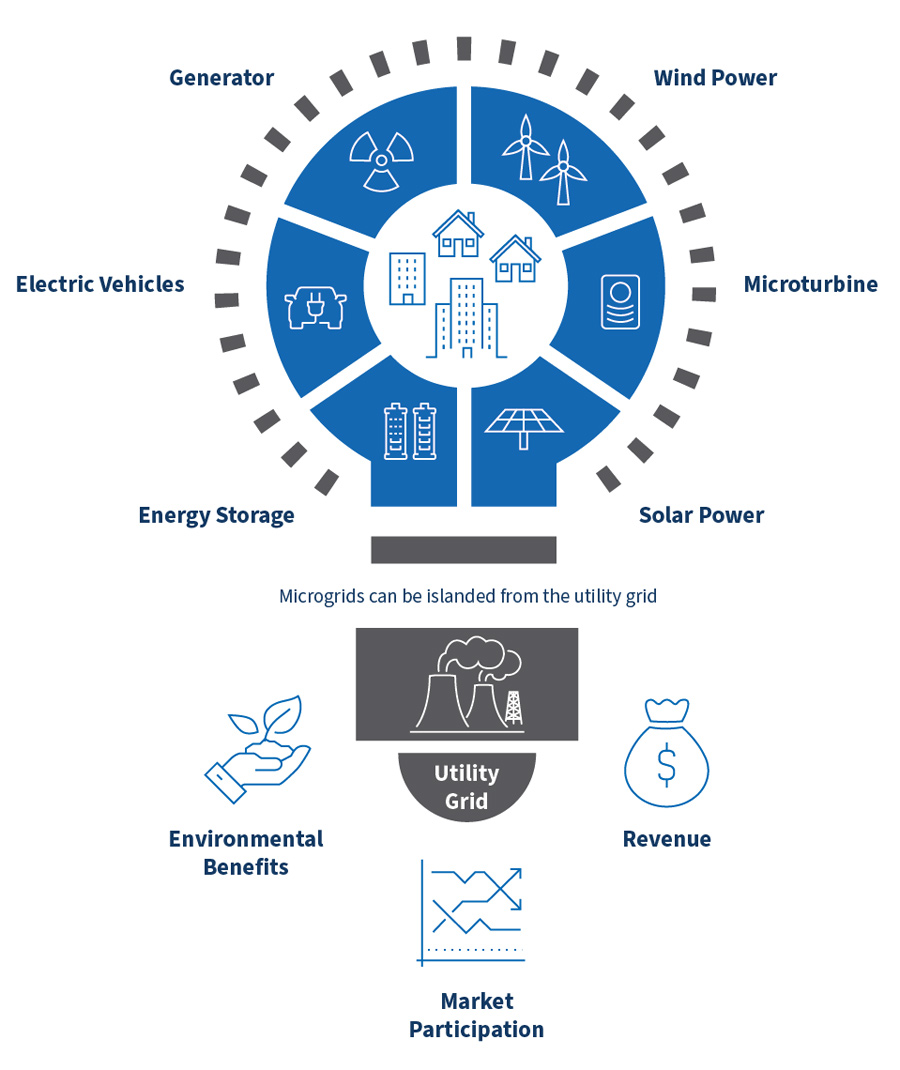Introduction to Resilient Energy Projects: Reliability and Carbon Reduction
-
June 28, 2022
DownloadsDownload Article
-
Historically, power resilience was primarily achieved by utilizing a variety of infrastructure hardening methods; however, as grid modernization has propagated through the industry, even more advanced approaches are being sought to enhance system resiliency. The concept of unwinding the centralized generation model by collocating generation assets with their load centers is seen as a logical choice to limit system failure exposure by bypassing the extensive transmission and distribution infrastructure needed to serve load from centralized generation sources. The use of distributed energy resources (DERs) and microgrids, co-located with their loads, has emerged as an industry trend for achieving enhanced power resilience and reliability.
However, if you are just starting to explore these tools, you may be asking, “How do you build a plan to leverage these resources for your resilience strategy?” Also, “Can carbon reduction goals and resilience be complimentary?” This article provides an overview of the policy strategies and business models that utilities, developers and owners can deploy to add these resources to their tool chest of solutions to drive toward zero outages and reduced carbon emissions. We will explore the strategies employed by successful deployments across the country, sharing best practices and stimulating potential solutions for future deployments.
How to Implement a Resilience Strategy
Over the last decade, utilities have made great strides in improving the speed of outage response and communication approaches during an outage event. However, this progress drove increased customer expectations; customers are now asking why outages continue to happen in the first place, making “just” quicker recovery no longer a sufficient response. As a result, utilities are exploring other opportunities to minimize outage disruptions by utilizing approaches such as strategic feeder hardening, advanced feeder monitoring, extensive distribution undergrounding and pole-top devices with sectionalizing capability. While these efforts can drive step-level improvements to reliability, they still fall short of the holy grail of zero outages every day.
Additionally, major weather events are not the only threat the power industry faces. Other high-impact/low-probability threats also provide unique sets of challenges that storm hardening alone cannot mitigate. This includes physical and cybersecurity threats, earthquakes, electromagnetic pulses and upstream supply issues. Utilities and customers alike must consider how these events could result in system disruption to critical infrastructure, which can impact a community’s ability to restore normal day-to-day activity. The implications are monumental, with utilities, developers, asset owners and regulators all exploring solutions that could minimize the impacts of these events.
Source: FTI Consulting
A promising approach lies with the strategic deployment of DERs and microgrids. By co-locating generation sources with load centers, transmission and distribution infrastructure exposure is minimized while the grid operator’s flexibility is increased. Additional benefits can include reduction in greenhouse gases, increased efficiency, flexibility of dispatching of resources and power quality improvements; these systems can also support non-wire alternatives to meet the needs of specific load growth areas, all of which are key tenets for sustainability.
These challenges require foresight and commitment of utilities, developers, asset owners and regulators to work together to pilot and implement solutions to mitigate outages while also supporting public policy goals. Lessons learned from successful policies and deployments can help inform new entrants on where to start approaches for their own unique resilience challenges. We explore these lessons in more detail through the following topics:
- The wide spectrum of DERs and microgrid deployments and implementations
- The different business models for DERs and microgrid deployments and which one is right for your application
- Developing a regulatory strategy for the implementation of your solution
- Why a community outreach plan is essential for supporting successful outcomes
Deploying DERs and Microgrids
A microgrid is a semi-autonomous power grid serving two or more loads within the greater utility grid. This means that a microgrid includes both DERs sufficient to cover critical loads and the control system necessary to isolate the system from the grid in the event of an outage. In a shift away from carbon-intensive technologies, microgrids increasingly use renewable power coupled with batteries or efficient combined heat and power (CHP) systems. By using smart technology, they have the capacity for automation and supervisory control and data acquisition (SCADA) integration to enable efficient resource allocation.
Microgrid and DER deployment present technical, cost and tariff considerations, which must be addressed before progressing too far into development. For example, microgrids must be able to connect to, and disconnect from, the main power grid without impacting other facilities or the reliability of the distribution feeder. As a result, the design of a microgrid and its operational requirements can have tariff implications and run afoul of utility franchise rights. Understanding how these issues play out in different jurisdictions drives a variety of business models for microgrid and DER deployment.
Balancing Costs and Benefits

Power Resilience & Reliability
- Understanding resilience requirements
- Evaluating operational losses from power outages
- Leaning the load through efficiency
- Identification of critical load
Cost
- Baseline tariff analysis
- Costs associated with carbon reduction requirements
- Cost of operational downtime
Carbon Reduction
- Building corporate value associated with decarbonization
- Decreasing emissions profile through green power generation
- Understanding how resilient power contributes to ESG goals
Source: FTI Consulting
Business Models and Success Stories
It is important for end users to appreciate a microgrid’s operating capabilities and local regulations in order to help optimize both the business model and technical solutions. Selecting the right business model can also minimize costs and maximize returns.
One of the most common business models and a success story for U.S.-based microgrids is the utility ownership model. This model simplifies interconnection and the ability to operate in isolation without requiring expensive new SCADA buildouts and associated infrastructure. Examples include National Grid’s Potsdam microgrid,1 used to enhance the resilience of the downtown Potsdam, New York area. This community microgrid successfully incorporated loads from several facilities in response to storm-related power outages. National Grid was able to take advantage of public microgrid grants available to the state for the project, which included substantial portions of line undergrounding.
Similarly, PG&E is pursuing microgrid ownership in California to serve some of their remote customers and minimize the fire risk associated with the wind-torn state.2 For end-use customers, direct utility ownership and operation removes a lot of technical, operational and regulatory hurdles.
With the proliferation of rooftop solar and energy-efficiency programs driving down power demand, utilities are searching for alternative business models to better serve their customers while exploring additional revenue streams. An example of this includes energy, or resilience, as a service, which is currently being piloted by Xcel Energy.3 The program partners the utility with customers to identify their resilient power requirements, and the utility then covers the required capital costs to build a microgrid through a special tariff with the customer. The utility maintains operational rights while avoiding most of the technical and tariff pitfalls seen in the private ownership model.
However, private ownership of microgrids is most successful when the campus being served can be easily isolated from the main grid, as with large commercial or industrial campuses at the end of a feeder, or a system such as a contiguous university campus where most of the distribution is not owned by the utility. One example is the Blue Lake Rancheria microgrid on a Native American reservation in Northern California, which provided renewable power, resilience and reliability for the tribe’s emergency services through fires, the COVID lockdowns and public safety power shutoffs.4
Finally, public–private partnerships can help cut through technical and regulatory barriers to bring microgrid development to fruition. Through partnerships with technology providers, utilities, or states and state grant initiatives, public–private partnerships can bring the right expertise and capital to the table to build a successful project.


Source: FTI Consulting
The Role of the Regulator
Regulatory changes for DERs and microgrids are being slowly pushed forward nationwide. Since microgrids are expensive, many owners or prospective owners are looking for ways to further monetize their assets through value-stacking or incorporating multiple revenue streams to enhance project returns. Traditionally, rate structures do not place value on resilience, and many utilities have viewed customer-owned distributed systems as an unreliable asset on the system requiring spinning reserves for coverage, resulting in cost-prohibitive standby charges. Commissions are starting to address these issues5 through new cost-allocation methodologies for standby and buyback service rates that will no longer penalize local DERs. Allowing storage assets, often included as a feature in microgrids, to add value through ancillary services is a practical example of a value stack. Design standards are another developing area of regulation, often led by the utilities themselves, and a critical step before monetizing system value.
The successful proliferation of microgrids depends on the decisions made by regulators now. Decisions to not penalize behind-the-meter resilience projects, or to take it a step further and recognize the value of resilience they bring to the market, will impact how stakeholders introduce these projects to the market.
Engaging Customers and Partners
Properly identifying and engaging all stakeholders early and often through proactive communication and education is essential to mitigating risk and avoiding future roadblocks in microgrid development. Furthermore, incorporating permitting authorities in discussions for environmental, siting and noise considerations early in the development process helps avoid unexpected issues down the line. Additionally, inclusion of any stakeholders who may peripherally benefit from a project, such as local economic development authorities, can also help build an advocate network for the project if roadblocks arise.
Next Up
Over the next several months, FTI Consulting’s Power, Renewables and Energy Transition team will publish deep dives on each of these topics to help readers explore how to address these topics for their business. Look for these articles in our series:
- The Resilient Project Value Stack
- Going to Market: Business Model Deep Dive
- Resilience and the Role of the Regulator
- Deployment and Stakeholder Engagement
Footnotes:
1: “Clarkson University Receives Approval On Design of Resilient Underground Microgrid.” https://www9.nationalgridus.com/aboutus/a3-1_news2.asp?document=8653
2: “PG&E Plans Utility-Owned ‘Remote Grids’ for Isolated Communities.” https://www.greentechmedia.com/articles/read/pge-plans-utility-owned-remote-grids-for-isolated-communities
4: “Creating environments that care, Blue Lake Rancheria.” https://new.siemens.com/global/en/products/energy/references/blue-lake-rancheria-resilient-microgrid.html
5: “New York adjusts standby, buyback rate methodologies, sweetening value proposition for NYC storage.” https://www.utilitydive.com/news/new-york-adjusts-standby-buyback- rate-methodologies-sweetening-value-prop/620919/?utm_source=Sailthru&utm_medium=email&utm_campaign=Issue:%202022-03-24%20Utility%20Dive%20Newsletter%20 %5Bissue:40611%5D&utm_term=Utility%20Dive
Published
June 28, 2022
 Key Contacts
Key Contacts
Global Practice Leader Power, Renewables & Energy Transition (PRET)
Senior Managing Director
Senior Managing Director
Senior Managing Director



